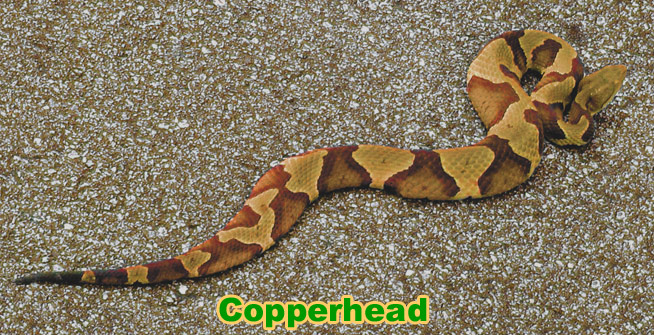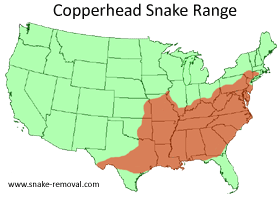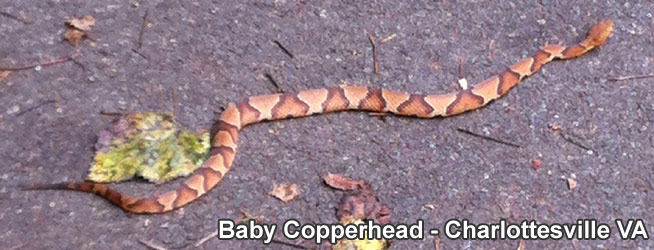The Copperhead is the most mis-identified snake in America! Did you see EXACTLY the below snake? Are you sure? It wasn't just one of a number of similar looking snakes, mostly water
snakes such as the Northern Water Snake? Snakes can be
very tricky to identify. Copperheads are rare, and people do see
them, so heck, maybe you did. In some areas they are more common than
in other areas.

Copperhead Appearance: Copperhead snakes are considered a medium sized snake with a wide body and a broad head. The snake has a distinctive neck, unlike in other species where that characteristic is indistinguishable. These snakes can be a light brown or tan in color with dark, irregular banding. The bands can be solid in color or can have a fading color appearance from the outside to the inside, from dark to light pigment. The markings often resemble a triangular shape, helping the snake to blend in with leaves on a forest floor.

Copperhead’s bites are rarely the cause of snake bite fatalities. When injected, their venom will cause severe damage to the local tissue and can pave the road for serious, secondary infection. Copperhead venom can be fatal, but often the snake injects very little of the poison when it bites a human. This minimal response is because the snake feels threatened. If the snake saw humans as a prey species, then it could inject enough venom to kill. Snake bites to people tend to be warning bites, and as such contain little venom. The most common venomous snake in the eastern states, copperheads are considered pit vipers, but unlike most other vipers, the copperhead does not flee when it is caught unawares. Instead, the snake will freeze in its current position. This is why copperhead bites are so common; people often step directly on the snake without knowing it is even there. Of all the pit vipers, copperhead venom is the least toxic.
Breeding does not take place every year, but a female snake will give birth to live young. Litters can consist of up to twenty young, though fewer than ten is most common. As with the majority of reptiles, the babies are on their own once they are born.
Copperhead Diet: Copperheads are carnivorous. They rely on a diet mostly of rodents, though some species have been known to eat large quantities of insects and amphibians. When cicadas are out in full force, copperhead snakes will climb trees to eat the large insects as they emerge.

Copperhead Facts:
An enzyme in the venom of copperheads has been discovered to inhibit the growth of cancer cells. This enzyme, called contortrostatin, is being studied for further usage in human medicine.
This snake gets its name from the unique copper hue present on the scales of its head. This copper coloring fades out and is not seen on the rest of the body.
During hibernation, copperhead snakes will share dens with rattlesnakes and black snakes, though contrary to common belief, the snake species cannot interbreed.
Copperheads use their brightly colored tails to lure prey to them, a practice called ‘caudal luring’.
How to Avoid a Copperhead Snake: Unfortunately, because of their amazing camouflage and unusual reaction of freezing position when in danger, avoiding copperhead snakes is not always easy. Most bites occur when a person isn’t even aware of the snake. If you are in copperhead country, always be aware. Snakes will often sun themselves on roadways, footpaths and rocks. A hunting snake will be concealed in vegetation or dense ground cover. Look before you step. Some hikers have found that the addition of a walking stick can make a difference.
If you or your pet is bitten by a copperhead, do not wait to seek medical treatment. Just because the venom of these snakes is considered mild by venom standards, doesn’t mean you can’t do serious, irreparable harm to your body by waiting for care. Any venom present in your system will spread by way of the circulatory system. For tissue-destroying venom like the copperheads, prolonged exposure can result in the loss of a limb. Like all pit vipers, this snake should be taken seriously and should be avoided if at all possible.
Below are some other species of snake that may look like a XXX:
Cottonmouth Snake
Water Moccasin
Northern Water Snake
Brown Water Snake
Banded Water Snake
Many people want to know how to kill a Copperhead snake, but you don't need to. The best way to get rid of Copperheads is to simply leave them alone. You can also use a Copperhead trap to catch them - that's one of the best ways for how to remove Copperhead snakes. For more information, go to my Snake Removal - How to Get Rid of Snakes home page.
Read about Snake Enemies - Animals that Catch Snakes here.
If you need Copperhead Snake removal in your city, we have snake experts these cities and over 100 other places: